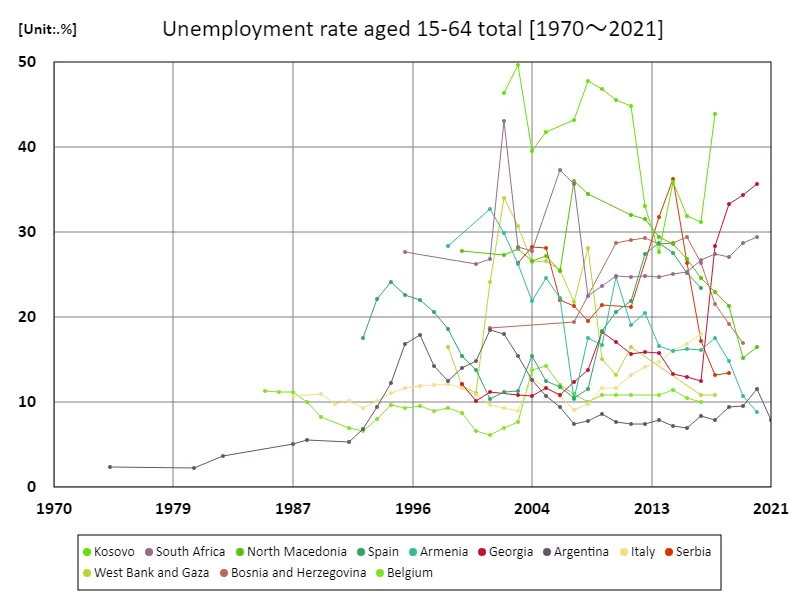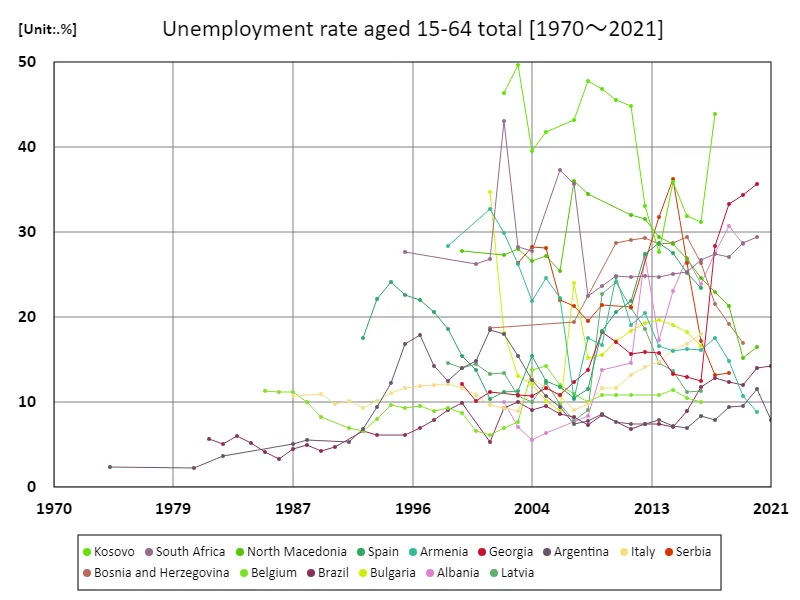Abstract
Employment underemployment rates, especially those aged 15-64, are strongly influenced by a country’s economic situation and policies. Data for 2021 showed Argentina recording a high unemployment rate of 7.93%, reflecting the effects of economic instability and inflation over the past few years. It is also noteworthy that youth unemployment has become a serious problem in many countries amid increasing non-regular employment and labor market flexibility. Furthermore, during the post-pandemic recovery process, the workforce is expected to be rebuilt and new industries will emerge, while education and skills training will become increasingly important. As such, trends in the unemployment rate are an important indicator of the health of an economy and reflect the specific characteristics of each country.
Ages 15-64, unemployment rate (percentage of total labor force)
Considering unemployment data from 1974 to 2021, Kosovo’s particularly extreme unemployment rate of 49.7% in 2003 can be seen as a result of war and economic instability. Kosovo has since seen gradual improvement and now has an employment rate of 88.4%, but this is still plagued by high unemployment. Other countries also tend to experience wide fluctuations in unemployment rates due to economic fluctuations and policy changes. For example, while employment increases during periods of economic growth, unemployment rates typically spike during recessions. Another characteristic of the country is a particularly high youth unemployment rate, which calls for improved education and skills. Overall, the unemployment rate is an important indicator that reflects a country’s economic policies and social background, and it is important to continue to monitor it closely.


The maximum is 49.7%[2003] of Kosovo, and the current value is about 88.4%
Unemployment rate (percentage of total labor force) for ages 15-64 (worldwide)
Unemployment data for those aged 15-64 from 1974 to 2021 highlights Kosovo’s staggeringly high unemployment rate of 49.7% recorded in 2003. This figure reflects social unrest caused by war and economic collapse. Kosovo has since improved its employment situation, with unemployment now standing at 88.4%, but it remains high. In contrast, unemployment rates in other countries also fluctuate widely with economic fluctuations. In particular, employment tends to increase during periods of economic growth, while unemployment rises sharply during recessions. Youth unemployment has also become a serious problem, and many countries are emphasizing the importance of education and skills training. Furthermore, technological advances and globalization are affecting the labor market, leading to an increase in non-regular employment and diversification of working conditions. As such, the unemployment rate is an important indicator of a country’s economic policies and social background, and its trends will require continued attention.


The maximum is 49.7%[2003] of Kosovo, and the current value is about 88.4%
Ages 15-64, unemployment rate (percentage of total labour force) (world, latest year)
The 2021 unemployment rate data for those aged 15-64 is notable for Gambia’s highest figure of 27.3%. This high unemployment rate is likely due to weak economic structures and barriers to young people entering the labor market. With the overall average at 9.91%, many countries have maintained a relatively stable employment situation, but some, such as The Gambia, are outliers. The combined unemployment rate of 159% suggests that there is a mix of different unemployment rates across countries. For example, in developing countries, job creation is not keeping up with the rate of economic growth, and high rates of non-regular employment are a problem. The pandemic has also led to increased unemployment in many countries, with the situation remaining particularly severe in countries that rely on the service and tourism industries. These trends are increasing the importance of education and skills training and creating a demand for improved quality jobs. Future economic policies will require sustainable job creation and labor market reform.


The maximum is 27.3% of Gambia, the average is 9.91%, and the total is 159%



Comments